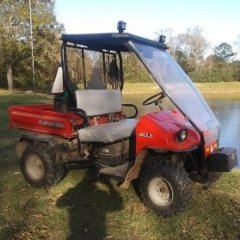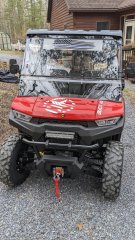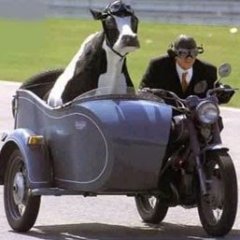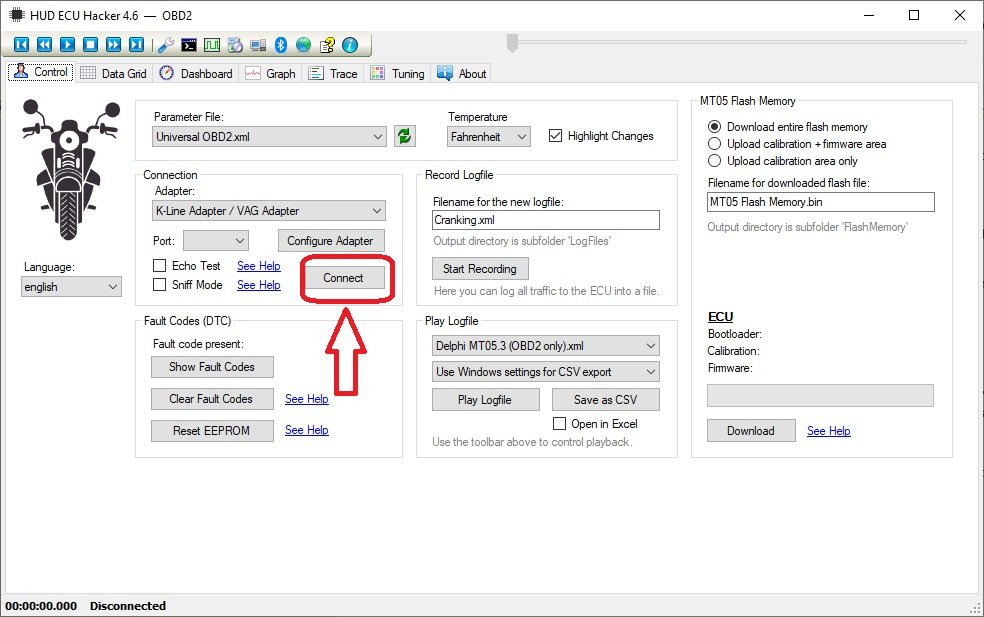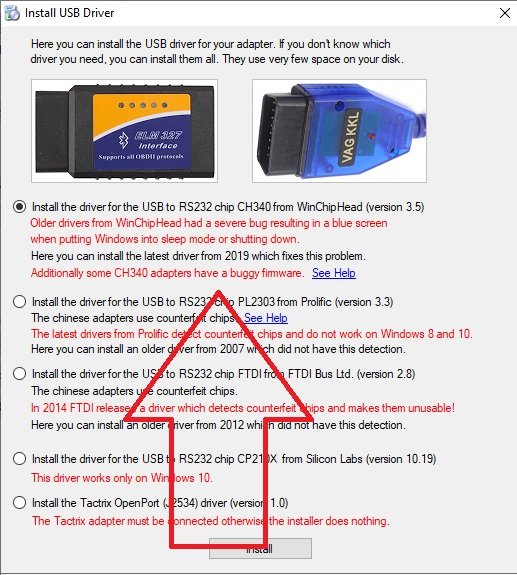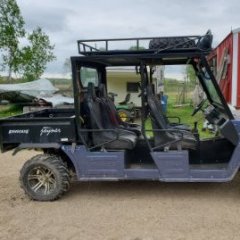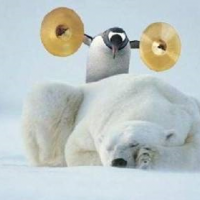Leaderboard
Popular Content
Showing content with the highest reputation since 04/23/2023 in Posts
-
Since I've seen some questions on this I took some pictures and will provide instructions on a valve adjustment for the UT400. This should be the same for the 550's and other various Coleman/Hisun single cylinder models with the cylinder slanted aft. I have seen several people ask of it is really necessary, and read several reports of valves being out of adjustment from the factory. My valves were .004" intake, and .010" exhaust with about 5 hrs on the machine. I've seen different numbers thrown around for factory spec, but I decided to go with 0.005". This is called valve lash. What is is is a gap between the rocker arm and the valve then the camshaft isnt opening the valve. Why does it matter? If it's too large the valve doesn't open all the way, if it's too small the valve dosent close. This can cause valve damage (overheating) as well as loss of engine power (burned fuel is going out exhaust rather than pushing the piston dow). Tools required : 5MM Allen wrench, 10MM box wrench, needle nose pliers, flat feeler gauge set, rags First you need to remove the fan cover on the passenger side. There is a cooling vent hose on the back side, remove the hose clamp and slide it off. From there there are 4x 10mm bolts holding the cover. The forward ones can be accessed from under the seat. Next remove the spark plug from the drivers side. Carefully wiggle the spark plug wire off. Grip it as low as possible and give it a little twisting motion as you pull it off to help free it. Its a tight fit for a socket, but there is a sheet metal wrench in the toolkit that fits it. Unscrew the plug and set it aside. This allows you to spin the motor over freely with no compression to fight. When you reassemble this is a good opportunity to switch to an NGK iridium plug for better performance/less fouling DR8EIX) Next you need to remove the intake and exhaust valve covers. The intake us the forward one. There are 3x 5MM Allen screws to remove. The Exhaust is the rear with 2x 5MM Allen bolts. Both covers have O-Rings instead of gaskets and are reusable. When you remove the rear be careful and use your rags as there will be oil that drips out. Next up we need to spin the motor over to top dead center. Grab each rocker arm and give em a little wiggle up and down. Spin the engine over by grabbing the fan with your other hand. Spin the engine over until both rockers have some wiggle and are loose. Once both rockers are loose slide the feeler gauge in like shown above. Try different feelers as needed to determine your starting spec. You should feel some drag but still be able to move the feeler without too much force. If you need to adjust, use the 10MM wrench to slightly loosen the locknut, then with the correct feeler gauge in place, tighten the top square nut while wiggling the feeler in and out. Once you have it right you need to tighten the 10mm lock nut without moving the square head bolt. Once the lock nut is tight recheck the clearance. That's it, button everything back up and make sure you have it all reassembled before running it again. If you find this helpful give me a thumbs up or comment. If you have any questions or need more help let me know. If there's interest maybe I'll do some more of these4 points
-
Hello to anyone who reads this. I am Jon and I own J&M Outdoor Power, a very small, small engine repair shop. I was approached by Coleman about 6 months ago to become one of their Warranty Centers. I recently received 3 different UT400's and a UT500 all with similar issues. These units range from 2 months to 2 years old. Customers state that the unit(s) was/were running fine, then heard a pop and a loss of power, two would no longer start. The two that would run would not achieve normal operating speed (around 20mph I would say) without redlining the RPMs. I quickly found that the Valve lash on each unit had become too large on some(both intake and exhaust) and too tight on one(just intake). After setting the gaps to .005(I found multiple different people suggesting bigger and smaller gaps, but no definitive Coleman Spec number yet) every unit starts, runs, and achieves top speed without issue. I don't know how many others have come across these issues, and I wanted to get something out on the web for others in the same predicament. Please let me know if you have had similar issues. Edit: I realize that this will not be a fix all solution for this issue, as the oil level and condition should be verified before moving to the valves. Many times improper oil conditions will cause valve lash to change. These units all have good oil and proper oil changes.3 points
-
Are you talking about an electric heater? if yes its likely too much current. There might be 10 amps of available current coming out of the rectifier that isn't already claimed by the ECU and factory lights. 10 amps @ 12V = 120 Watts, which is about what an electric heating pad runs. If you're talking about a fan for a engine coolant based heater it's probably ok. If you have accessories and the running voltage is below 13.5V you have too much stuff attached. If the battery light comes on it means the battery is actively being discharged while running. Stator based charging systems on these things and tractors etc are really meant to power the ECU and factory systems not to provide a lot of extra power for other stuff, it's not like the alternator on a car.2 points
-
2 points
-
The main trick is tilting the front end up. Block the rear wheels and jack up the front end at least a foot. A convenient ditch works well also.....rear wheels in a shallow ditch. The head bleeder screw should be opened. With the engine NOT running, almost fill the radiator (leave some air to avoid a mess) and burp (squeeze the lower hose line before the metal tube at the engine base passenger side floor area). Watch the radiator and the the bleeder. With the radiator "higher" than the head bleeder, the air should be bled and coolant dribble out. Close the bleeder and refill radiator (your clue you displaced the air with coolant) and start the engine. Burp more while running and if you get the circulation going the hoses will warm up. More bubbles should surface at the radiator filler neck. Shut off engine. Open bleeder and release any air in the head. The puke jug needs to be filled about an inch above the full cold line. Use a shop towel as a "seal"and use an air nozzle to SLIGHTLY pressurize the puke tank removing the air from the tubing line to the radiator neck. Then the radiator starts to overflow, a third hand can install the radiator cap. Run the engine and determine the head and hoses are at the close to the same temperature (as in warming up) through out the system. IR temp gun....fairly cheap now....can get real numbers. Scan the radiator, hoses, cylinder and head.....if all close you are done. Recheck fluids when done riding. Recheck the bleeder and top off the puke jug as required.2 points
-
From the look of the picture on the post, I can think of a couple things2 points
-
Its' not a car, this is a motorcycle engine with a small stator charging system. You can't expect to run high wattage accessories like a heater or huge light bars on these things . That will overwhelm the charging system, drain your battery an stop your engine. Could damage the charging system and voltage regulator too. You only have about 10 amps extra to run any accessories including lights.2 points
-
My dealer gave me an electronic version of the service manual and I have sent it to Kingfish. I will see if it will upload here for others to use. I'm not sure if there is a more appropriate way to do this, let me know if there is.. 2015-2017 Service Manual - Sector E1.pdf2 points
-
my Hisun in my Massimo , sold by Tractor Supply, assembled in Dallas, say Made In China on every part of all of it .. Altho it now has multiple Yamaha parts mixed in. lol2 points
-
https://motorcycledoctor.com/wp-content/uploads/2021/08/Valve-Adjustment-HiSun-2.pdf This should do it.2 points
-
Yeah, I adjusted mine multiple times without any luck. I had extended the shifter rod, as mentioned on this board, as well as some videos I watched, and that resolved the shifting issue. Now, after it slips into forward or Reverse, it never slips out. PS: If you go this route, remember to readjust the cable to compensate for the extended shifter. I had to do the adjustment an couple times after extending the shifter and then the problem was resolved.2 points
-
I finally found a service manual in stock and was able to make the adjustments per the specs!2 points
-
Problem was using cheap eBay injector. Bought quality one and hot pipes went away. Running like new.2 points
-
2 points
-
Massimo MSU500 won't shift to low I would check the shift linkage. Adjust it make it a little longer, if it is not long enough it won't shift to low2 points
-
Hello again! I now have a pretty good running Coleman UT400 after a top end rebuild, wet clutch rebuild and a repaired crankcase... ! It plows snow great, but I was also having the jumping out of gear problem, mainly reverse, but a couple times out of forward. I would quickly place it in N and then let the engine idle down and shift again. This worked most of the time. I did some research and found that some have modified the shift linkage. The problem with just adjusting the shift cable is that it really NEEDS more throw, not an adjustment. From what I've read and viewed on the Internet, the linkage arm needs to be about 3/4" longer to gain more throw in both directions. On YouTube, the guy had to remove the shift linkage hole trim and notch the side of the dash to get the shift linkage off the pivot pin. BUT this is NOT necessary. When the "E" clip has been removed and you fish it out of the firewall somewhere, the shift lever is now loose. I had to pop the top of the shift knob off, remove the retaining screw and then heat the lower portion of the knob to get it to come off the lever. Once you have the shift lever loose, push it towards the right to slide it off the pivot shaft. But it won't come off just yet. Use a small pry bar/screw driver and slide the nylon flanged bushing out of the left side of the lever. This lets the lever slide off and get into a "loose" condition and it will twist and come right off without removing the dash trim, that could be a bugger to get back on correctly. Once the lever is off, press out the other bushing so when you're welding on the linkage arm, you don't melt the bushing. I found a piece of scrap metal the same thickness as the lever arm, just over 1/8" thick, close to 3/16". I cut my arm and beveled the edges for better welding. I added a piece just over 5/8" long and kept about a 1/16" gap between the arm and the new piece. Once welded on bother ends, it adds up to just about 3/4" or so. I reinstalled the lever after painting it and did an adjustment on the cable. By the way, it's easier to remove the cable from the bracket on the frame. This gives you more clearance to maneuver in that area with your hands. ALSO, you will need to get a 12" adjustable wrench and slide it over the cable mounting bracket and tweak, to the front, the steel so the cable is pointed upward a bit to now realign with the new longer shift arm lever. There's more than enough metal for the tweak and it will line up perfectly. I now bottom out the shifter on the transmission BEFORE I run out of throw on the shifter... I've tested it just a bit so far and it shifts much better with the longer throw. One of the Coleman authorized repair facilities said that he worked with Coleman to get a new part that's longer by 3/4". He's modified a few and it works perfectly for him. Just doing the cable will just short you on the other end. Here's some pictures of my modified shift lever etc.2 points
-
In order to connect with the ECU we need two cables. The first is a USB ODBII cable. HUD ECU Hacker’s documentation has a lot of different confusing options, but here’s what I went with and managed to get working, the cable is called “VAG KKL” it is a USB to ODB2 cable. It is available from a variety of sources for $10-15. The second thing we need is a “6 pin delphi to ODB2” adapter cable. It is also available for a similar price. In my case I ordered both from ebay, but there are other sources. Once we have our cable in hand we need to find the plug it in on your machine. My personal rig is a Coleman UT400, but the wire location should be similar for all Hisuns. My cable was located under the middle of the seat area. Just inboard of the battery, where the main wire harness split loom runs. The cable is a 6 pin (3x2) with a dust cap. Remove the dust cap and plug in the 6-pin end of the Delphi adapter cable. Note: When I was done, I left the 6-pin adapter connected, and zip tied it so it now runs to in front of the battery for easier access in the future. Next download and install HUD ECU HACKER DOWNLOAD Open HUD ECU Hacker on your PC It should prompt you to choose a driver to install. This particular cable uses the “CH340” driver (First choice on the menu) click to install, once installed hit the X in the corner to go back to the main page Once the driver is installed plug in the USB Cable, and plug the ODB2 end into the 6 pin adapter. The red led on the adapter should light up indicating it has power. Drop down and pick a com port on the main screen, it should show the VAG KKL adapter as a com port. Click connect on the main menu. It will pop up a bunch of fast scrolling text indicating it is connecting. Once connected you can click through the various tabs to see different data sets. The main menu also has the option to show fault codes, clear fault codes, reset the EPROM back to factory. The other function that may be helpful is recording a log file. You can record a log while operating the unit, and come back later and replay it to try to better diagnose what is happening. Within the various pages you will see the reading from each sensor. Sometimes a sensor reading will be off enough to cause running issues, but not enough for the ECU to realize its an issue. For example if the engine thinks it’s really warm, but its actually cold, it may not inject enough fuel to start. There are also more advanced functions, like adjusting fuel mapping, but that is beyond the scope of this tutorial. Full HUD ECU Hacker Documentation (Very technical reading) If you find this helpful give me a comment below or a thumbs up.2 points
-
The needle adapter shown in the first post makes it so you don't need to be straight perpendicular like with a traditional grease gun coupler, You need to make sure you're buying the blunt type like that, there are also sharp needles meant for piercing rubber in ball joints, etc. With the blunt needle adapter you basically shove it into the check ball. It does make a bit more of a mess than a normal coupler, but it does fit. The driveshaft zerks are certainly have limited clearance. The other option is a small grease gun that just fits on top of the zerk without coupling. You can see one pictured in the "rear driveshaft" pic Something like this1 point
-
1 point
-
hi, am not an expert or a mechanic, but on my post, (just joined today feb24th), i mentioned how i repositioned and upgraded my battery to a 12v car batt, instead of the weak and expensive OEM's, i placed it under the driver seat and bought thicker cables, the red i ran it thru the floor and up to the front firewall where the solenoid and fuse is (i deleted the plstic box), the red went there and the black i got a 36 inch and bolt it to the frame, cart starts good no issues, 2010/11 hisun 500cc carburated,. just an opinion, good luck.1 point
-
Same problem with mine. Ended up being starter clutch. Did mine in frame. Had to remove a few things but not too bad of job. Pulley puller is ideal. Got clutch on ebay $27. Look for : Starter Clutch component 23706 For Linhai 260 300 400 ATV UTV Scooter BigHorn1 point
-
I have a Gator 550 UTV with two rows of seats and dump bed. I bought new UTV LED lights for front and back and have mounted them on the roof, no problem I now need help hooking and running wires from lights to switch. Does anyone know someone near Millbrook Al that could do this? If so, please give me contact info.1 point
-
Yes just the lower one is leaking now. I ordered some banjo washers with o-rings and I'll try some tape when I reinstall. Thanks!1 point
-
The one I used and linked above is a generic chart. Unfortunately there is very little information on Hisun... and I guess Coleman machines... Maybe becuase Hisun is a knockoff of the Yamaha Rhino, at least the older Hisuns. For ours I try to get aftermarket Yamaha Rhino parts when I can as usually they are cheaper and more accessible. But I don't think it works that way for the new machines as they aren't really copies anymore... unless they are and I don't know. Luke1 point
-
If you take the two nylon bushings out of the lever, you DO NOT need to remove the rubber seal and bezel. The lever just slides off the shaft quite easily. I was one of the first to do this modification. AND FOR ME, it's been the FIX! I plowed two days ago for over two hours and never once did it jump out of either forward or reverse. If the cable system has been really abused, and the unit has been jumping out a LOT, this may not fix the issue. It's very possible that you might have internal issues that only new parts can fix. But be rest assured, that if you do not do the 3/4" extension on the lever AND replace new parts internally, you will be right back jumping out of gear all over again. Most anyone can take the lever off and take it somewhere to be extended. Even realigning the cable bracket after the lever has been extended, is quite easy to do. Good luck! I'm VERY happy with my little UT400. I cannot believe how much snow this thing can push with the 60" wide blade. Because of my driveway size and shape, getting out every few minutes to change the angle pin, was not an option. I bought the hydraulic power angle upgrade and installed that. It's not the fastest to change angles, but it beats getting out to do it. I also upgraded to the fabric vinyl enclosure. In 10 degree weather with some wind, I can plow in tennis shoes and not have to wear gloves. Have not installed an auxiliary heater... Yet.:) Dan Lockwood, Clare MI.1 point
-
Hey Folks, I have a BMS Ranch Stallion 4x4 that has been a really good UTV. I have recently burned the belt out by using it to get a tractor back on its feet after someone dumped it on its side. I found the belt online (380.00 bucks) and I have pulled the cover off to expose the belt. I pulled the old belt off but can not figure out how to reduce the tension on the pulleys. I do not know how to loosen the nut that hold the clutch on as it just spins the whole drive, how do i hold the spindle the nut threads onto? I can not find anyhing on the web about the bms ranch stallion and belt replacement. Anyone ever work on one of these?1 point
-
Update. Got the engine out, & removed the piston. Cylinder walls look fairly decent; no scoring I can see or feel. The 2nd ring on the old piston snapped in half as I was taking it off the piston, & they were very worn. I think that's the issue. I'll finish putting it back together tomorrow, then perform the leak down while it's on the bench. With any luck, this will fix it so it'll last another year or two. Next time, I'll just get a remanufactured engine; there's a place here in St. Louis that sells the complete engine for $950. Joey1 point
-
Ryan I don't see where it would be any different than any other engine. Ask Redbeard. Google him on youtube. I know he runs some and he likes to remove the governor.1 point
-
The stickers on my Hisun (Axis is the Lowe's badge) show made in Vietnam.1 point
-
Yeah get the piston tdc and then adjust them but that was the problem with my 2019 550colman1 point
-
1 point
-
1 point
-
1 point
-
Here is a post I made about the cfmoto over on their forum. Can see what could happen if the cvt belt gets wrapped around the sheaves https://cfmoto-forum.com/uforce-600/2013-uforce-transmission-locked-up/1 point
-
Jim, Try this link to a service manual. It will cost you 5.95 but well worth it. I tried sending my copy but couldn't get it to load correctly. You should be able to get instructions and clearances. Is it running bad or you are just checking? Does your engine have the two barrel carb? https://subaru-robin.servicemanualvault.com/Subaru-Robin-EH65-Engine-Service-Manual.html1 point
-
Maybe a dumb question, but do you have your foot firmly on the brake pedal? Mine would do the same thing, unless I pressed hard on the pedal. I did some adjustments to the brake switch, and the problem was solved.1 point
-
I don't think that is a valid error code. You can look on this website to verify HUD ECU Hacker (netcult.ch) I have this software along with the real Tetris adaptor and I can connect to the dephi ECU, read and reset error codes. I tried the cheap route as far as adaptors go but ended up buying the real thing. Here's the link to the delphi ECU manual. Microsoft Word - Delphi_CTC_Small_Engine_EMS_Service_Manual_Rev1_Eng.doc (netcult.ch) At the end of the manual are all the error codes and there isn't a 1111 listed.1 point
-
I found out quickly that the bushing was a 2-piece plastic bushing. With the inside bushing out of the shifter, you can rotate the lever to the side and it will all come out without having to remove the bezel. Once all apart and cleaned up, all the pieces were loose and lubricated for reassembly. Like I said, you should bend down the cable bracket mount just a bit to re-align the cable end with the lever. I used a large Cresent wrench to bend the bracket without any problem. Good luck with your revision! Dan1 point
-
Buy new and buy quality. Otherwise you will have to spend your time sharpening your mechanic skills. Good luck.1 point
-
This is why Kawasaki has a 3 year warranty. you're still within the warranty period, i'd let the dealer perform any adjustments it may need.1 point
-
No idea, but I welded mine closed. No issues so far.. machine is much quieter without a pencil size exhaust leak..1 point
-
I own a 2013 kawasaki mule 4010 diesel 4x4 and I've replaced the wheel bearings in the left front 4 times over the past year. Twice with oem bearings and Twice with aftermarket bearings. Any help would be greatly appreciated.1 point
-
I currently have a 2011 Polaris 400 H.O. that has fewer than 300 hrs on it. My buddy bought it new and I bought it with around 100 hrs. I use it around the farm and to get between two properties that are about a mile apart. I am tired of dealing with the choke when its cold or even cool out. It starts fine and runs ok if your driving but until it gets completely warmed up if you pull up to a gate and get off to open it will die. And because of the choke my wife has a hard time with it. Before I got the 400 I had a 2013 polaris 500 midsize that was fuel injected but aways ran rich and foul plugs. I had it at two different dealers and neither one could fix it. So I sold it and bought the 400. My father in law has a 2015 Polaris 570 midsize which is fuel injected and it is hard to start and cranks more than it should. Needless to say I am done with Polaris and ready to sell mine and move on to something better. I have been looking at the Honda Pioneer 700 and the Kawasaki Mule Pro MX. I was disappointed to learn the Kawasaki Mule Pro MX engine is built by Hysun and not Kawasaki, but that maybe a non issue. Maybe I'm missing another good option that I haven't considered. The main thing is getting something that is bullet proof reliable. Any feedback would be greatly appreciated. Thanks in advance1 point
-
There's this thread, which I contributed to a few months ago: I replaced my Discovery batteries with four ReLion Insight 48V batteries, which have the same form factor as the old batteries. I went with them because of that, but mostly because each battery has a max continuous output of 100A, so the four of them combined can match the full 400A capability of the motor. Also their tech support was great and sent me the new charging profile and instructions so I could flash the existing onboard charger to change it over to their custom lithium battery charging profile. The fact that you can still see 400A with your original batteries is interesting, since I was never able to see that and was at the point of the UTV slowing down and throwing error codes when hauling uphill. The upgrade isn't cheap, so you may want to make sure you're at the point where you just can't squeeze out anything more from your old batteries. That said, the performance improvement is great. Four batteries is plenty of capacity for my use, but if you require maximum range (and don't mind the cost) you can actually parallel 8 of them and still save almost half the weight compared to the Discovery batteries.1 point
-
I only had mine 12 days before the motor blew and they refuse to fix it. I will need to find a new motor and don’t want to mess with a hisun motor as they are obviously a waste of money(they want $7k to replace). any advice on where to find parts or what is interchangeable would be much appreciated.1 point
-
Obviously Joe you're on an anti-HISUN mission. Just speaking for myself, I'm tired of your constant bad mouthing my machine!! You've made your point, get a life!1 point
-
Yep. Mine is the same. This shows you have a full tank. The indicators will disappear from right to left as it consumes fuel.1 point
-
The major issue with Joyners is scarce parts support stateside. John Deere uses a CVT on their 825i - no gear shift cable that I know of that works on the Renegade. The shift cables have different part numbers for the same cable. One has a eye on both ends of the cable P/N: S800.05.02.02-R2 or 02.S800.05.02.02 (two different part numbers, same cable). The other cable has a threaded nut on one end, eyelet on the other P/N: S800.05.02.01-R2 or 02.S800.05.02.01 (two different part numbers, same cable). If you can't find someone who can build you a new cable, maybe, just maybe Joyner-USA can help. if you can find and contact them. They're in Mesa, AZ. Their phone number to their address at 1050 West Main in Mesa 480-882-9612. Their Riverview and 18th Pl addresses are way out of date. I was able to get two tires w/rims and two headlights from them in stock. But that was a few years ago.1 point
-
Dont recall the name of it.. I just Googled UTV engine rebuilders ..Picked one, I emailed the Owner.. he said he was 99% sure one of his YAMAHA rebuilts would bolt up where my HISUN is now.. The Hisun is a Yamaha CLONE.. .. He also said it for any reason it did not, he would take it back.. He also had free shipping .. If mine fails again, I will likely go that route . Currently mine is still running1 point
-
Your stator is a 3 phase "Y" output. The winding "LEGS" are the 3 white wires......call/label them A B C. Look at a parts list to see the stator is a laminated steel ring with a multiple of 3 poles---like 12 or 15. The windings are connected BUT NOT TIED TO GROUND at the starts----thus the schematic Y look. Each leg is wound in series on every 3rd pole and act like stacking a string of batteries in a 5 cell flashlight....except the poles produce AC. The AC output is measured from white to white, white to white, white to white.........A-B, B-C, and C-A. Idle voltage is around 20 VAC leg to leg (3 times). Higher RPM will produce on some systems around 80 VAC.....CAREFULL HERE. The resistance check (here again leg to leg) is thru 2 sets of pole coils.....IN one of the whites----to the center tie point----OUT to the 2 other white wires. Measure A-B, B-C, C-A...... .2 to .3 ohms. Also check for any path to GND....high M ohm scale should be infinite as in open circuit. A 120V/40W light bulb will glow when connected A-B, etc. Some systems will blow the bulb if motor Rs too high Your problem with the melted connector plug was corrosion. The connection resistance will heat up the terminals and with enough heat, melt the nylon connector body......this goes on for a while THEN it goes BAD when the terminals touch.....shorting out the STATOR windings. If opened up, you will find the varnish burned off 2/3 of the 2 legs effected. The coils short down and the resistance check will be sub .1 ohm. Output voltage test will NOT be equal leg to leg also. As an added bonus, the stator will cook off with additional engine run time. I found that the voltage REG will still be good.....burned terminals and all.....most of the time......but die later. The RED wire goes to the + battery terminal. Black goes to GND....- BATTERY POST. Test with a test light to ensure a good connection as in probe to REGULATOR RED wire and clamp to GND AND probe to REGULATOR BLACK wire AND CLAMP TO BATTERY + POST. Voltmeter will lie to you and say a good connection. An example would be BLK test lead to GND......lick finger and touch RED meter lead AND use another finger to touch the + battery terminal.....meter will read 10 to 12 VDC...says you have a good 12V....NOT. BONUS HINT: finding the correct connector and terminals to match the REGULATOR might be tough. FIX is to use a aftermarket RICK's regulator that has pigtails.......cut and strip both stator and regulator wires.....match R and B......the 3 ph whites don't matter...totally random mix when harness was produced and regulator has 3 identical input circuits. TEST STATOR FIRST FOR DAMAGE/FAULTS.1 point
This leaderboard is set to New York/GMT-04:00




